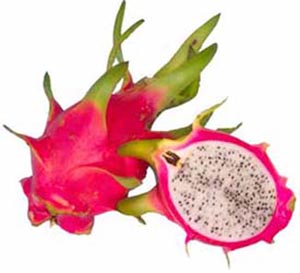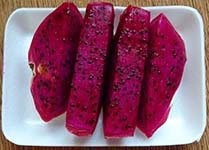Dragon Fruit Nutrition Facts
Sweet and juicy, dragon fruit comes from plants within the cactus family originating in Central America, specifically in the genus Hylocereus. Known as Pitahaya or Pitaya in Western markets, it enjoys popularity in various Southeast Asian countries, notably Thailand, Malaysia, and Singapore. Commonly referred to as strawberry-pear, thanh long (Vietnamese), Huolóng Guo (Chinese), Doragonfurutsu, and Kæwmangkr (in Thai), this fruit boasts diverse names across cultures.
Its botanical name is Hylocereus undatus.
 |
| Dragon fruit-Hylocereus undatus. Note tiny black seeds and rice-white fruit pulp. Courtesy: Hylocereus undatus |
There are three common types of Dragon fruit species:
Red fruit coat with white flesh (Hylocereus undatus): The most common type.
Red fruit coat with red flesh (Hylocereus polyrhizus).
Yellow fruit coat with white flesh (Hylocereus megalanthus).
Hylocereus species thrive under tropical climates. Typically, farmers prefer using cuttings from mother plants for plantation rather than seedlings. As a delicate stem plant, the pitahaya cactus requires a trellis for support and upright growth.
Dragon plant begins fruiting in the second year of plantation. In April, the plant produces many attractive, cream-white colored flowers that bloom at night. Fruits are ready for harvesting 30-35 days after successful pollination of flowers. The fruiting period, starting in June, continues until November. Mature fruits are harvested frequently, up to six times during this period.
Immature dragon fruits have a bright green outer skin, which turns bright red as the fruit matures and ripens. Inside, the flesh is juicy, semi-translucent, and pearly-white, adorned with black seeds evenly dispersed throughout. Its texture resembles that of kiwifruit, while its flavor is reminiscent of melons.
Health Benefits of Dragon Fruit (Pitaya)
Dragon fruit, akin to kiwifruit, boasts modest calorie content, approximately 50 calories per 100 g. However, it packs a punch with abundant antioxidants, minerals, vitamins, and fiber, offering a plethora of health benefits.
Rich in Phytoalbumin: The crunchy black seeds of dragon fruit harbor Phytoalbumin, an antioxidant phytochemical compound. Phytoalbumin plays pivotal roles in enhancing appetite, acting as a laxative, and rejuvenating skin and hair health.
Dragon fruit stands as an excellent source of antioxidant vitamin C, delivering approximately 8-9 mg per 100 g or roughly 12-15% of the Daily Recommended Intake (DRI). The consumption of vitamin C-rich foods aids the body in bolstering its resistance against infectious agents while neutralizing harmful free radicals.
The red flesh variety of pitahaya boasts healthy levels of vitamin A and carotenes. These compounds possess antioxidant properties crucial for optimal vision and the maintenance of healthy mucosa and skin. Moreover, the consumption of fruits rich in carotenes is linked to protection against lung and oral cavity cancers.
Dragon fruit contains noteworthy amounts of essential minerals such as phosphorus, manganese, iron, and magnesium. Manganese serves as a co-factor for the potent antioxidant enzyme superoxide dismutase, while magnesium contributes significantly to bone health alongside calcium.
| Principle | Nutrient Value |
|---|---|
| Energy | 50 Kcal |
| Protein | 0.159- 0.229 g |
| Total Fat | 0.21- 0.61 g |
| Dietary Fiber | 0.7- 0.9 g |
| Vitamins | |
| Thiamin | 0.28- 0.043 mg |
| Riboflavin | 0.043- 0.045 mg |
| Niacin | 0.297- 0.43 mg |
| Vitamin C | 8.0- 9.0 mg |
| Minerals | |
| Calcium | 6.3- 8.8 mg |
| Iron | 0.55- 0.65 mg |
| Phosphorus | 30.2- 36.1 mg |
| Phyto-nutrients | |
| Carotene | 0.005- 0.012 mg |
Selection and storage
Fresh dragon fruits typically hit the markets in Thailand from the end of June through November. However, advancements in farming, storage, and transportation technologies have made it possible for fresh pitahaya to be available year-round.
When selecting dragon fruit from stores, seek for those with green tips on the scales, indicating freshness. Ripe fruits should yield to gentle thumb pressure. While they can be found for most of the year, their peak season runs from June to December. Only mature fruits are harvested from the H. undatus cactus vine with meticulous care for commercial purposes.
Once at home, ripe fruits are best enjoyed promptly after purchase. For prolonged freshness, store them in the refrigerator for up to three days. Cut sections, when wrapped in thin plastic, can maintain their quality for up to a week if stored in the refrigerator at an appropriate humidity level.
Preparation and serving methods
 |
| Red pitaya-cut sections. |
To prepare dragon fruit, start by washing it in cold running water. Fresh, ripe fruits are best enjoyed on their own without any additional seasonings or additions, as their peel is tough and inedible. Simply cut the fruit in half and scoop out the flesh using a spoon. Alternatively, you can cut it into slices or cubes.
Here are some serving tips:
Fresh, juicy pitahaya is delicious enough to be enjoyed as it is, without any seasoning or additions. Revel in its rich, unique flavor and the crunchiness of its tiny black seeds.
Incorporate the flesh into shakes, sorbets, smoothies, or fruit cocktails with ingredients like coconut water, lime juice, or honey.
Add fresh pitaya chunks to fruit salads for an extra burst of flavor and texture.
Utilize dragon fruit in the preparation of jams, marmalades, jellies, or party cakes to elevate your culinary creations.
Safety profile
Dragon fruit rarely causes allergic reactions, making it safe for consumption by pregnant mothers and children. Please refer to the medical disclaimer for further information.
≻≻-Back to Fruits from Dragon fruit. Visit here for an impressive list of all varieties of fruits with complete illustrations of their nutrition facts and health benefits.
≻≻-Back to Home page.
Further reading and Resources:
Stanford School of Medicine Cancer information Page- Nutrition to Reduce Cancer Risk.